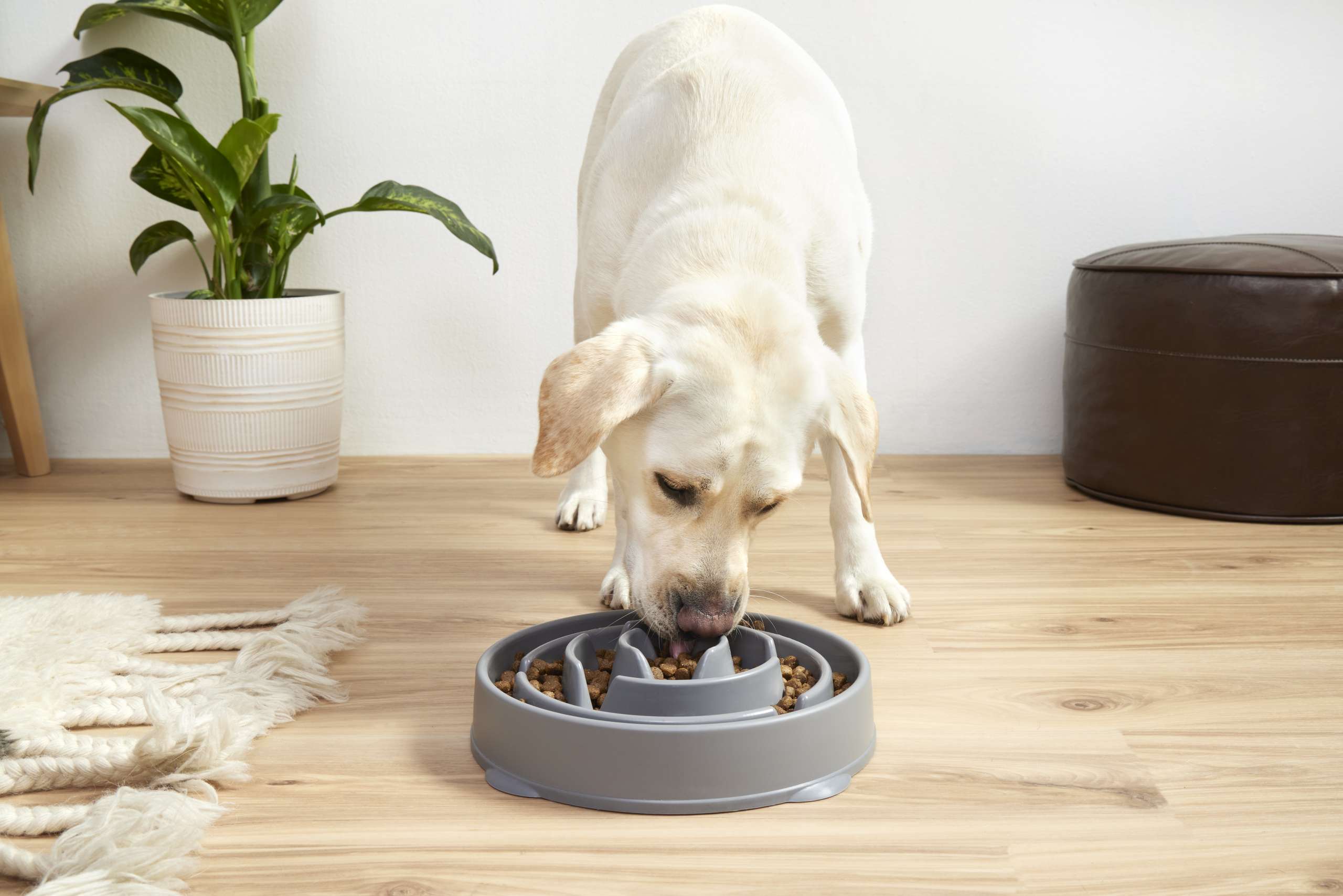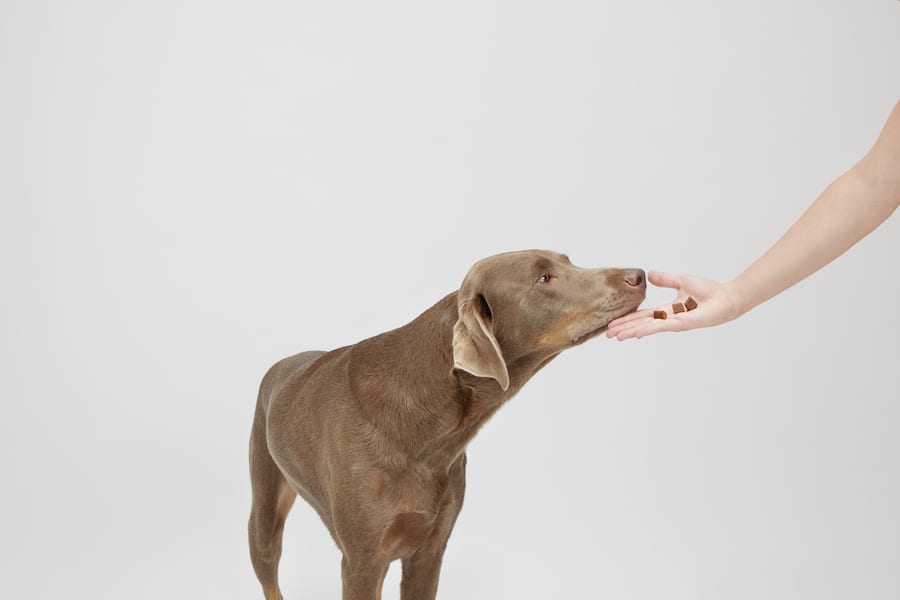For Pups With Short Attention Spans…
Labrador retrievers are one of the most popular dogs in America, so if you are thinking of getting one you should know that common health problems to look out for are elbow and hip dysplasia, obesity, osteochondritis dissecans, exercise-induced collapse, and ear infections.
Strong but gentle, sweet and loyal, goofy and energetic—with qualities like these, it’s no wonder the Labrador retriever is one of the United States’ most popular dog breeds year after year.1
But like all dog breeds (and humans!), Labrador retrievers are born with certain genes that make them prone to certain health conditions. The most common Labrador retriever health issues include joint problems like hip dysplasia, liver disease, eye issues, and weight-related concerns like obesity and heart problems.


If you’re devoted to keeping your Lab healthy for years to come, reading up on the most common Labrador retriever health issues can help you spot, prevent, and care for any problems they may encounter in their lifetime.
6 Common Health Problems for Labrador Retrievers
Labrador retrievers are a generally hardy breed, but there are a few ailments you should watch for. Let’s take a look at 6 of the most common health obstacles your nuzzly friend may run up against and their symptoms.
#1 Obesity
Labs love their snacks, and with those big sad eyes, they’re champions at convincing their humans to hand over the treats. But when Labrador retrievers gain weight, it can lead to health problems like:2
- Diabetes
- Heart disease
- Liver disease
- Blood diseases
- Respiratory problems
- Contributes to joint problems like elbow and hip dysplasia
- Lower life expectancy
For most Labs, a healthy weight ranges between 55 and 75 lbs. You can test this by gently feeling their torso:
- In healthy Labs, you should be able to feel your dog’s ribs and spine easily
- Likewise, when you look down at their back from above, you should observe their sides tapering inward from the rib cage to the hips
The perfect diet can make a big difference in your dog’s weight. Always do your own research when picking the right food for your dog, but if you need a place to start, try BARK Food for Labs! Pro Tip: Get 25% off with code 25FOOD and free shipping!
#2 Elbow Dysplasia
Labrador retrievers are prone to several disorders of the joints and bones, including elbow dysplasia.3 Elbow dysplasia occurs when the three bones comprising a dog’s elbow joint don’t fit together correctly, which can lead to:
- Joint atrophy, pain, and inflammation
- Limping or lameness
- Arthritis
The cause of elbow dysplasia is still unknown, but it’s thought to be related to genetics as well as factors like injury, diet, and impaired development during puppyhood.
If your lab has elbow dysplasia, you may notice:
- Limping on a front leg, especially after running or playing
- Difficulty using one or both front legs
- Early onset of symptoms (elbow dysplasia can develop in dogs as young as 5 months old)
Veterinarians diagnose elbow dysplasia by examining a dog’s range of motion and ordering X-rays or other imaging tests. Elbow dysplasia requires surgery to treat, but the prognosis for pups is usually good—especially if you catch it early.


#3 Hip Dysplasia
Hip dysplasia is another degenerative joint disorder common in Labradors. It occurs when the hip joint doesn’t fit correctly in its socket, which can lead to arthritis, lameness, and sometimes debilitating pain. In Labradors, hip dysplasia affects males more frequently.4
If you’re worried your Lab may have hip dysplasia, keep an eye out for the following symptoms:
- Limping
- Loss of muscle tone in the hindquarters and back legs
- A hopping gait when running
- Slowness or reluctance to stand up
- Reluctance to climb stairs, jump, etc.
It’s important to have your Lab checked for this condition regularly, especially if they’re showing any signs of discomfort. Hip dysplasia usually requires surgery to treat, and the earlier it’s performed, the better.
#4 Osteochondritis Dissecans
Osteochondritis dissecans is a condition where the cartilage in a joint is cracked, torn, or separated from the bone.5 It usually occurs in the shoulders, elbows, hips, and knees.
While the causes aren’t fully understood, osteochondritis dissecans may be related to diet, injury, circulatory problems, or genetic factors. It’s more common in male Labs, and it usually arises when dogs are about 6 to 9 months old.
If your dog develops osteochondritis dissecans, you may notice signs such as:
- Limping or lameness (limping may be persistent or come and go)
- Sometimes swelling or heat in the affected joint
- Signs of discomfort like crying or whimpering when the joint is touched or moved
Treatment protocols for this condition depend on how severely the cartilage is torn. If the tear is minor, rest and anti-inflammatory medications may be sufficient for promoting healing. In more severe cases, Labs may require surgery to repair or remove damaged cartilage.
#5 Exercise-Induced Collapse
Exercise-induced collapse, or EIC, is a genetic disorder that causes hind-limb weakness in Labradors after exercise, excitement, or strenuous play.6 EIC can cause dogs to collapse and sometimes lose consciousness, and it typically sets in when dogs are about one year old.
EIC can be dangerous or even fatal, so if you see any signs of weakness, wobbly legs, or uncoordinated movements it’s important to have your dog stop exercising immediately.
The first sign of EIC is usually a change in gait. You may notice:
- Stiff, awkward movements, or dragging of the hind legs
- Post-exercise staggering or incoordination
- Weakness, especially in the hind legs
- Excessive panting
- Collapse
- Elevated temperature
If your dog has EIC, vets usually recommend avoiding excessive exercise altogether. So while your pup won’t be able to run laps around the dog track, most dogs with EIC can live normal lives.


#6 Ear Infections
Those floppy ears are undeniably one of the cutest features of your Labrador retriever—but they can also trap moisture and dirt, leading to ear infections. Moreover, because most labs love water, they’re more likely to get moisture in their ears after swimming or bathtime.
Some common signs of ear infections in dogs include:
- Head shaking
- Scratching, rubbing, or pawing at the ears
- Smelly ears
- Reddened ear canals
- Black, yellow, or brownish debris or discharge inside the ears
If you suspect your Lab has developed an ear infection, it’s important see your vet ASAP. Not only are ear infections painful, but they can lead to more serious problems if left untreated. Similarly, ear infections may be caused by a variety of factors (from bacteria to ear mites), and you’ll need an accurate diagnosis in order to treat it properly.7
How to Keep Your Labrador Retriever Happy and Healthy
Learning about potential health problems in your pup can feel scary, but there are plenty of preventative steps you can take to keep your Lab frisky as ever. Let’s look at our top tips for promoting Labrador retriever health.
#1 Provide Plenty of Play Time
Labrador retrievers are active dogs, and they need exercise daily to maintain a healthy weight. A good rule of thumb is at least 30 minutes of exercise per day—walking, playing fetch, swimming, etc.—divided into several shorter sessions.
Finally, providing a nutritionally balanced, Labrador retriever-specific diet (and measuring out portions) can help keep yours trim and strong. And, while it can be difficult, do your best to stay strong before those soulful eyes and keep your dinner leftovers on your plate!
#2 Consider Adding Another Dog To the Family
If you have trouble giving your dog enough exercise and playtime, a companion dog like a Golden retriever, Boxer, or Beagle can help. Doggy friends can also help reduce boredom and separation anxiety if you’re away from home during the day.
A second dog can be a big commitment, so account for these factors before doing so:
- Make sure you have enough time and space for two dogs
- Consider your current dog’s personality, energy level, and compatibility if you’re choosing another dog breed
- Ensure your budget can accommodate the feeding, medical, and grooming expenses of two dogs
- Consult with your vet or a local Labrador rescue society to find the best fit for your family


#3 Level Up Their Care
Regular vet visits are the best way to catch health problems before they become serious. Many Labrador retriever health issues are highly treatable—and more cost-effective to do so—when they’re detected early or prevented altogether.
Furthermore, genetic testing can determine whether or not your Lab is at a higher risk of developing certain health conditions (e.g. joint disorders). DNA testing can also detect the genetic mutation connected to EIC.6
#4 Get a Health Clearance From Your Labrador Breeder
At BARK, we encourage owners to adopt whenever possible. Popular breeds like Labradors are frequently found in shelters and rescue societies, waiting for a warm new home.
That said, if you’ve decided to get a Labrador retriever puppy from a breeder, it’s important to take steps to ensure your new family member is healthy. Reputable breeders perform genetic testing on both parents and puppies, so they should be able to provide you with a health profile of your new Labrador puppy.
Show Your Lab Some Love With BARK
Your Labrador retriever showers (and sometimes slobbers) you with love every day. Give them just as much love in return by taking care of their health with routine care, plenty of daily exercise, affection, mental stimulation, and regular vet visits.
One of the best things you can do for your Lab is to nourish them with high-quality, nutritional food tailored to their specific breed. For meals specifically designed to help Labradors live a long, active life, check out BARK’s pup provisions. Our dog food boasts the right balance of nutrients, antioxidants, and omega fatty acids to prevent the most common Labrador retriever health issues before they start.
Sources:
- American Kennel Club. Most popular dog breeds of 2021. https://www.akc.org/expert-advice/dog-breeds/most-popular-dog-breeds-of-2021/
- PetMD. Obesity is a common problem in labrador retrievers. https://www.petmd.com/dog/care/evr_dg_obesity_problem_in_dogs_labrador_retrievers
- American College of Veterinary Surgeons. Canine elbow dysplasia. https://www.acvs.org/small-animal/canine-elbow-dysplasia
- American College of Veterinary Surgeons. Canine hip dysplasia. https://www.acvs.org/small-animal/canine-hip-dysplasia
- VCA Animal Hospitals. Osteochondritis Dissecans (OCD) in dogs. https://vcahospitals.com/know-your-pet/osteochondritis-dissecans-or-ocd-in-dogs
- University of Minnesota College of Veterinary Medicine. Dynamin-1 associated exercise-induced collapse. https://vetmed.umn.edu/research/labs/canine-genetics-lab/genetic-testing/exercise-induced-collapse
- VCA Animal Hospitals. Ear infections in dogs (otitis externa). https://vcahospitals.com/know-your-pet/ear-infections-in-dogs-otitis-externa





